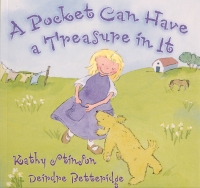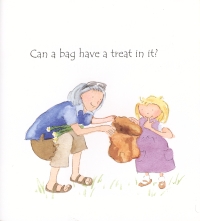| ________________
CM . . .
. Volume XIV Number 18. . . .May 2, 2008
excerpt:
This picture book explores the concept of 'in it' specifically meaning one object being located inside of another. Written in first person, the text utilizes, as narrator, a young girl, roughly five or six years of age. The setting is not urban, but rather one of a farm house or country home. There is mention of a grandmother and a baby, as well as visual representation of a mother and father to the child. All characters are Caucasian. There is no main storyline to the book which simply deals straightforwardly with the concept of 'in it.' Like other picture books written by Kathy Stinson, the text is simple and to the point, not venturing far from the concept being dealt with. The language used in this book is appropriate for the age group at which it is aimed. Each page contains little text but does not sound choppy or contrived because of the author's choice of naturally occurring speech as well as her technique of questioning the reader. The author poses questions for readers to answer themselves while reading along, an element that will surely be appreciated by anyone reading this story aloud to a pre-school classroom or any room of new readers. These questions instill the story with a great sense of humor that children would surely enjoy. Other than dealing with the main concept ('in it'), this book includes underlying themes of kindness, generosity, value for ones family, surprise, discovery, healthy eating and proper hygiene.
Recommended. Jessica Peterson is a student in the Early Years Education Program at University of Manitoba. She holds a degree in Fine Arts and is currently student teaching in a Nursery/Kindergarten classroom in Winnipeg, MB.
To comment
on this title or this review, send mail to cm@umanitoba.ca.
Copyright © the Manitoba Library Association. Reproduction for personal
use is permitted only if this copyright notice is maintained. Any
other reproduction is prohibited without permission.
NEXT REVIEW |
TABLE OF CONTENTS FOR THIS ISSUE
- May 2, 2008.
AUTHORS |
TITLES |
MEDIA REVIEWS |
PROFILES |
BACK ISSUES |
SEARCH |
CMARCHIVE |
HOME |

 In keeping with the book's simple and to the point writing style, the illustrations are quite simple and uncluttered as well. Simple and bright watercolour illustrations filled with patches of light warm colours leave a large amount of white space on each page for a large and playful font. This font and the book's general uncluttered appearance give the work a more approachable feel which would appear less intimidating to a child who is in the beginning stages of literacy development. The illustrations on each page do not include more than necessary, allowing the child to focus on the object that is being portrayed inside the other. Although the illustrations set up a visual both for characters and setting that are not introduced in the text, there are very few distinguishing features to the characters or setting, thereby leavings readers to focus more on the text and to let their imaginations guide them.
In keeping with the book's simple and to the point writing style, the illustrations are quite simple and uncluttered as well. Simple and bright watercolour illustrations filled with patches of light warm colours leave a large amount of white space on each page for a large and playful font. This font and the book's general uncluttered appearance give the work a more approachable feel which would appear less intimidating to a child who is in the beginning stages of literacy development. The illustrations on each page do not include more than necessary, allowing the child to focus on the object that is being portrayed inside the other. Although the illustrations set up a visual both for characters and setting that are not introduced in the text, there are very few distinguishing features to the characters or setting, thereby leavings readers to focus more on the text and to let their imaginations guide them.